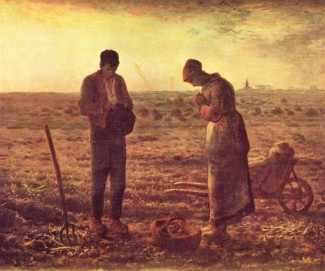
I was well-educated in the liberal arts and studied Millet’s painting of “The Angelus” in a cultural heritage course years ago. In the painting, the peasant woman’s head is bowed in prayer, her husband stands motionless beside his digging fork, and the potato field stretches around them with a faint church spire in the distance. Something in the stillness, something in the quiet, spoke to me, though I was not then Christian, and my conversion to Catholicism was years in the future.
Why were they bowing their heads? What was this Angelus prayer anyway? It was not until after converting to Catholicism that I began to recite it. I printed out a copy of the prayer (traditionally said at 6 a.m., noon, and 6 p.m.) and stuck it in the basket by my side of the bed. It stayed there, in crumpled form, for quite some time. Then one day—who knows how the Holy Spirit or the God-nudge work—I began to chant The Angelus at bedtime when darkness settled over me.
V: The Angel of the Lord declared unto Mary.
R: And she conceived of the Holy Spirit.
Hail Mary, full of grace…
V: Behold the handmaid of the Lord.
R: Be it done unto me according to Your Word.
Hail Mary, full of grace…
V: And the Word was made flesh.
R: And dwelt among us.
Hail Mary, full of grace…
Let us pray: Pour forth, we beseech Thee, O Lord, Thy grace into our hearts, that we to whom the Incarnation of Christ Thy Son was made known by the message of an angel, may by His Passion and Cross be brought to the glory of His Resurrection. Through the same Christ Our Lord. Amen.
Why does this old Catholic prayer, which celebrates the Incarnation, survive and continue to have meaning for us? Scholars think this Marian devotion followed by the ringing of the church bells began as early as the 12th-century. It’s based on verses from the infancy narratives of the Gospels of Luke and John.
Most of us know the beginnings of the Christmas story from Luke when Gabriel appears to Mary: “The Angel of the Lord declared unto Mary and she conceived of the Holy Spirit.” When I repeat these words of the Angelus, I sense I am joined to something bigger and deeper than my tiny, individual self. I feel tied to the Gospels, imagining the angel appearing before Mary who was surprised and probably a little afraid.
The second part is based on a verse from the Gospel of Luke: “Behold, I am the handmaid of the Lord. May it be done to me according to your word.”
My daughter once said she found this way too subservient for her. I get that. But it’s not a problem for me. I see Mary opening her heart to God and saying, “I am with you, whatever you wish.” That’s faith, and it reminds me to look at my own life to see where I might open my heart wider to God.
“And the Word was made flesh, and dwelt among us,” is the third verse of the prayer, this one from John. In these words, I see the fire and passion of our creator working through time, putting it all into the body of Jesus as he becomes one of us.
“Declared.”
“May it be done to me.”
“Word made flesh.”
Do you see the progression? The Word is given—Mary consents—and we celebrate the enfleshed word at Christmas. The verses of the prayer end with a request that we be made worthy of the promises of Christ, and that his grace enters into us.
The Angelus keeps the Incarnation ever before me. As someone once said, “The Rosary is the Bible on a string.” So, too, the Angelus is the Incarnation woven together with prayer and bells, directing my eyes toward Christmas and the miracle when Word became flesh.